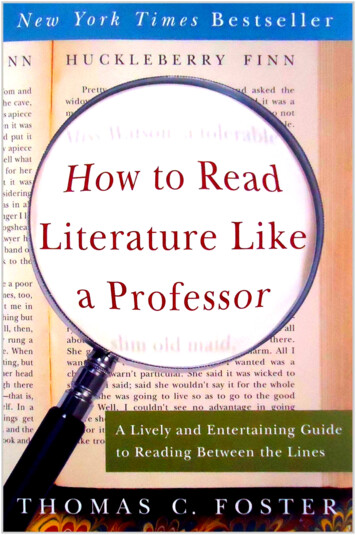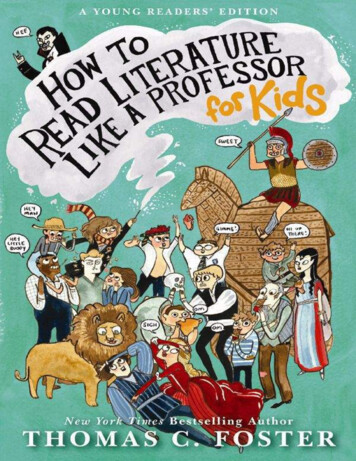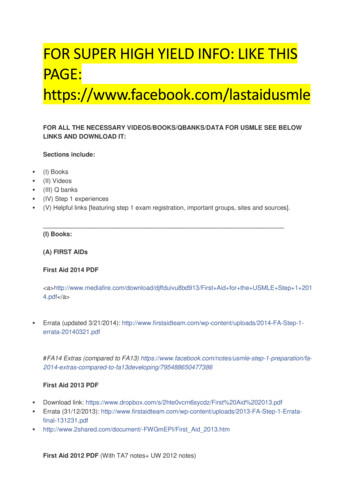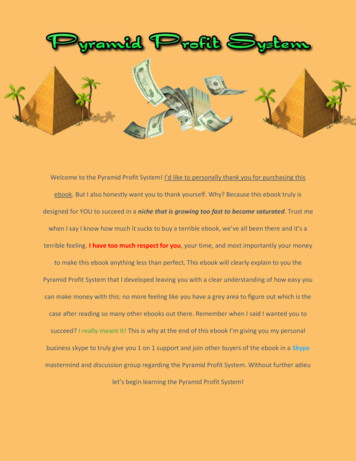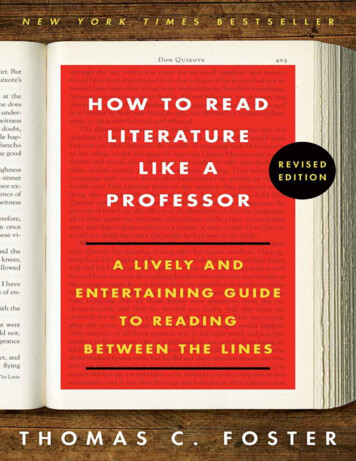
Transcription
DedicationFor my sons, Robert and Nathan
ContentsDEDICATIONPREFACEINTRODUCTIONHow’d He Do That?Every Trip Is a Quest1. (Except When It’s Not)2. Nice to Eat with You: Acts of Communion3. Nice to Eat You: Acts of Vampires4. Now, Where Have I Seen Her Before?5. When in Doubt, It’s from Shakespeare . . .6. . . . Or the Bible7. Hanseldee and Greteldum8. It’s Greek to Me9. It’s More Than Just Rain or Snow10. Never Stand Next to the HeroINTERLUDEDoes He Mean That?11. . . . More Than It’s Gonna Hurt You: Concerning Violence12. Is That a Symbol?13. It’s All Political14. Yes, She’s a Christ Figure, Too15. Flights of Fancy16. It’s All About Sex . . .17. . . . Except Sex18. If She Comes Up, It’s Baptism19. Geography Matters . . .
20. . . . So Does SeasonINTERLUDEOne Story21. Marked for Greatness22. He’s Blind for a Reason, You Know23. It’s Never Just Heart Disease . . . And Rarely Just Illness24. Don’t Read with Your Eyes25. It’s My Symbol and I’ll Cry If I Want To26. Is He Serious? And Other Ironies27. A Test CasePOSTLUDE:Who’s in Charge Here?ENVOIAPPENDIX:Reading ListACKNOWLEDGMENTSINDEXAbout the AuthorPraise for How to Read Literature Like a ProfessorAlso by Thomas C. FosterCopyrightAbout the Publisher
PrefaceTHE AMAZING THING ABOUT BOOKS is how they have lives of their own. Writers think they know theirbusiness when they sit down to compose a new work, and I suppose they do, right up to the momentwhen the last piece of punctuation gets planted on the final sentence. More often than not, thatpunctuation is a period. It should be a question mark, though, because what occurs from then on isanybody’s guess.The classic example is the writer whose best book goes thud upon release. Think Herman Melvilleor F. Scott Fitzgerald. Melville must have thought, after finding large readerships for earlier novels,that the crazed search for the white whale would be a smash. It wasn’t. Nor was Fitzgerald’s tale of aromantic dreamer trying to rewrite his past. The Great Gatsby is so much subtler, so much moreinsightful about human nature and its historical moment, than his earlier books that it is almostinconceivable that his huge audience turned away. On the other hand, maybe that is why it turnedaway. Successfully predicting the coming calamity looks a lot like an excess of gloominess—until thedisaster arrives. Humankind, observed Fitzgerald’s contemporary T. S. Eliot, cannot bear too muchreality. In any case, Fitzgerald lived only long enough to see his books largely out of print, hisroyalties nonexistent. It would take another generation for the world to discover how great Gatsbytruly is, three or four times that for Moby-Dick to be recognized as a masterpiece.There are also tales, of course, of unexpected bestsellers that go on and on, as well as flashes inthe pan that flare up but then die out without a trace. But it’s the Moby-Gatsby kind of story thatcompels our attention. If you want to know what the world thinks about a writer and her work, checkback with us in, oh, two hundred years or so.Not all stories of publication switchbacks are so stark. We all hope to find an audience—anyaudience—and we believe we have some idea who that will be. Sometimes we’re right, sometimeswe’re all wet. What follows is a confession of sorts.The customary acknowledgments and thanks are typically placed at the back of the book. I wish,however, to recognize one special debt of gratitude to a group whose assistance has beenmonumental. Indeed, without them, this revision would not have been possible. A dozen or so yearsago when I was drafting the original, I was pretty clear on the audience for my book. She was a thirtyseven-year-old returning student, probably divorced, probably a nurse forced back to coursework bychanges in the licensure rules of the profession. Faced with the prospect of obtaining a bachelor’sdegree, she chose to follow her heart this time around and pursue a degree in English. She had alwaysbeen a serious reader, but she had felt that she was missing something in her experience of literature,some deep secret her teachers had known but not imparted to her.You think I’m kidding, right? I’m not. Teaching at a branch campus of a famous university, I meether, or her male equivalent, the guy (usually, although there are women as well) laid off from the
assembly line at General Motors, again and again. And again. One of the great things about teaching atthe University of Michigan–Flint, as opposed to the University of Michigan, is ceaseless contact withadult learners, many of whom hunger for more learning. I also have plenty of the typical-collegestudent type, but the nontraditional students have taught me a few things. First, never assume anythingabout background experience. I’ve had students who have read all of Joyce or Faulkner orHemingway, and one who had read more Czech novels than I could ever hope to get through, as wellas students who had read pretty much only Stephen King or Danielle Steel. There have beenHitchcock fanatics and devotees of Bergman and Fellini, and others who thought Dallas was high art.And you can never tell which will be which.Second, explain yourself. They expect, and are sometimes more vocal about it than their youngerclassmates, to see how the trick is done. Whether they think I am the high priest or the high charlatan,they want to know how the magic works, how I arrive at my sometimes idiosyncratic readings.And third, teach precepts, then stand aside. Once I show these older students how I work withtexts, I get out of the way. This is not because of the wonders of my approach or my teaching; chiefly,what happens is that I validate something about their own way of reading that gives them permissionto run free, and run they do. Younger students do, too, but they are often more inhibited, having spenttheir whole lives inside classrooms. There’s nothing like being out on your own to make youintellectually self-reliant.Are these older students all geniuses? No, although a few might be. Nor are they all closetintellectuals, although more than a few are—you know, the sort who get nicknamed “Professor”because they’re seen reading books on their lunch break. But however smart they may be, they pushme and school me even as I do the same to them. So I figured there must be others out there like them.And it was for that group that I wrote this book.Boy, was I wrong. I was right, too. I have heard from quite a lot of mature readers, some of whomfit the above descriptions, others who had been English majors in college but who had been left withthe feeling that something was missing, that some key element of literary study had passed them by. Iwould receive the occasional e-mail from such readers. Then, about two years in, the nature of thosemissives changed. I started hearing from English teachers. Not often, but every once in a while. Andabout six months after that, I started hearing from high school students. The teachers were uniformlyglowing in their praise, the students mostly so. With just enough hate mail to make it clear that thiswasn’t a put-up job. One student said, in one of the more printable messages, “I don’t know what thebig deal is. Everything in your book I learned in ninth grade.” I told her I would like to shake herninth-grade teacher’s hand. And no refunds. It was also at about this time that I heard indirectly thatthe book was being discussed on a site for Advanced Placement English teachers.In the years since, I have been blessed to have contact with teachers and students from around thecountry. There have been all sorts of inquiries, from “What did you mean by X?” to “Can I apply thisnotion to that book that you didn’t discuss?” to “Can you look over my thesis sentence (or my wholepaper)?” The first two are great, the latter less so, since it puts me in an awkward ethical position.Even so, it is flattering that students trust a complete stranger enough to ask such questions.I have also had plenty of direct interaction. I go into several classrooms a year to talk with classes
about the book and how they’re using it. These visits are a lot of fun and almost always involve agreat question or two. Needless to say, the in-person visits are largely limited to places I can drive ina few hours, although I did once go as far afield as Fort Thomas, Kentucky. I have also, thanks to thewonders of the digital age, been able to engage with students electronically. Diane Burrowes, thequeen of academic marketing at HarperCollins, stays up nights thinking of new and strange ways toget me, or at least a digital version thereof, into classrooms from New Jersey and Virginia toFlagstaff, Arizona. And of course the development of platforms like Skype has made such visitsalmost commonplace.What has struck me most in the ensuing years is the endless inventiveness of secondary Englishteachers in general and AP teachers in particular. They have figured out ways to use this book thatwould never have occurred to me if I taught for a thousand years. In one class, each student isassigned as the keeper of a chapter; if Sam is in charge of rain and snow, he makes a posterexplaining the significant elements of the chapter, and whenever the reading involves precipitation,Sam is prepared to discuss its implications. I suspect Sam got a raw deal and has to work harder thanalmost anyone else, but maybe he likes being busy. In another class, students work in groups to makeshort movies, and every movie must incorporate at least one concept from the book. At the end of theyear, they have a mock-Oscar ceremony, complete with tuxedos and statuettes (used sports trophies,I’m told). Now that’s just brilliant. What I like best about many of the schemes is the degree of studentautonomy built into them. I suspect that one of the appealing elements of the book is that it lacks theapparatus of a textbook, which allows teachers to make of it what they will—and they make manydifferent things of it. In turn, many of them pass that open-endedness along to their students, permittingthem to be creative with the text and their own insights.Is that the key to the book’s popularity among teachers? I don’t know. I was amazed when I firstheard that it was being adopted for courses, my thoughts revolving around the utter absence ofacademic trappings (things like notes, glosses, and questions at the end of chapters, which, by theway, I’ve always hated) and the scattershot organization. I grouped the discussions in a way that feltright to me, but that’s not the same as making sense for classroom use. Indeed, I am not sure whatwould make sense in a classroom setting, since I have never, and would never, use the book in acourse. How’s that for a confession? It is not an excess of modesty, a thing of which I have neverbeen accused, that prevents my using it. The reason is more practical. This book contains most of myliterary insights and all my jokes. If I assigned it, I would have nothing left to do. The goal ofeducation, as I see it, is to bring students to the point where they no longer need you—in essence, toput yourself out of a job . . . but that retirement would be a little more sudden than I’d prefer.So when I heard that teachers were assigning the book as summer reading, I was more than a littleastonished. That it has found a home in high schools is testament to the creativity and intelligence ofsecondary teachers of English. They’re working at a time when, we’re told, no one reads anymore,yet they somehow manage to inspire a love of reading among their students. They work incrediblyhard, grading work by as many as 150 students at a time, a load that just thinking about would makemost university professors woozy. They get far too little respect and not nearly enough pay for doing aremarkable job. One of my more waggish colleagues, noting my frequent visits to secondary classes,
says that I could have my pick of any high school teaching job in America. He’s wrong, of course. Icouldn’t keep up with the people already there.To the English teachers who have made How to Read Literature Like a Professor a success, I canoffer only my profound gratitude. That this book is even in print, much less in the process of beingrevised, is all your fault. I can’t thank each of you individually, but I would like to thank somerepresentative members of the tribe: Joyce Haner (now retired) of Okemos High School (Michigan),for many late-night discussions at, of all places, softball team parties, as well as for being my firstwelcomer among Michigan teachers; Amy Anderson and Bill Spruytte of Lapeer East High School(Michigan); Stacey Turczyn of Powers Catholic High School in Flint; and Gini Wozny of Academy ofthe Redwoods in Eureka, California, all of whom sent their—and their students’—recommendationsand suggestions for the new edition. Literally dozens of others have offered suggestions in person orvia e-mail over the years, and to each of you, many, many thanks. What you do is far more importantthan any book.The changes to this edition are modest but, I hope, significant. Most significant, to my troubledmind, is that I was able to remove or correct two or three howling blunders. No, I won’t tell you whatthey were. It’s bad enough I’ve had to live with them, so I certainly won’t broadcast my folly. Andthere are quite a few fit-and-finish issues I was able to resolve, little matters of grammar andorthography—needless repetitions of words or phrases, an unhappy word choice here or there, theusual niggling matters that make it so hard to read one’s own work and that make one think, “Surely Icould have done better than that.” But there are also matters of substance. The chapter on sonnetshape was generally deemed not to fit the rest of the volume. It’s about form and structure, really,when the rest of the book is about figurative meaning and the way meaning deflects from one object oraction or event at the surface level to something else on another. If, like me, you always liked thatchapter, fear not. I’m planning a discussion of poetry, quite possibly in e-book form, so that chaptermay reappear in a couple of years. The chapters on illness, heart and otherwise, have been shortenedand run together; it felt as if the text was straining for length there.In their place, I added a chapter on characterization and on why being buddies with protagonists isso bad for the health of second fiddles. There’s also a new discussion on public versus privatesymbols. One of the central precepts of the book is that there is a universal grammar of figurativeimagery, that in fact images and symbols gain much of their power from repetition andreinterpretation. Naturally, however, writers are always inventing new metaphors and symbols thatsometimes recur throughout their work, or that show up once and are never heard from again. In eithercase, we need a strategy for dealing with these anomalies, so I try to oblige.I have also included, as a path toward increased analytical confidence, a meditation on takingcharge of one’s own reading experience, of understanding the reader’s importance in the creation ofliterary meaning. It’s surprising to me how, even as they actively create readings of their own,students and other readers can still maintain an essentially passive view of experiencing texts. It’shigh time they gave themselves more credit.Of course, literature is a moving target, and thousands upon thousands of books have beenpublished in the decade or so since the book appeared. While there is no need to overhaul the
references and examples from edition to edition, I have used a few illustrations from more recentpublications. There have been some terrific developments in poetry, fiction, and creative nonfictionin the last few years, even for those of us who are not enthralled by teenage vampires or JaneAusten’s novels beset by monsters and parasitic adaptations. Mr. Darcy’s Second Cousin’s WifeGets a Hangnail. That sort of thing. Against those trends, however, we can set the appearance oftalented newcomers as well as work by established masters in the various genres, writers as diverseand interesting as Zadie Smith, Monica Ali, Jess Walter, Colum McCann, Colm Tóibín, MargaretAtwood, Thomas Pynchon, Emma Donoghue, Lloyd Jones, Adam Foulds, Orhan Pamuk, Téa Obreht,and Audrey Niffenegger. And that’s just the fiction writers. There have been startling new finds andpainful losses. We sometimes hear of the death of literature or of this or that genre (the novel is afavorite whipping boy), but literature doesn’t die, just as it doesn’t “progress” or “decay.” It expands,it increases. When we feel that it has become stagnant or stale, that usually just means we ourselvesare not paying sufficient attention. Whether it’s the untold story of a famous writer’s wife or the racialnewcomers to a changing Britain or America or a boy in a lifeboat with a tiger or a tiger in a Balkanvillage or a man on a wire between the Twin Towers, new tales, as well as old tales with newwrinkles, continue to be told. Makes you want to keep getting up in the morning just to see whathappens next.While we’re on the subject of thanksgiving, I would like to express my gratitude to a criticallyimportant population. Every time I meet with students, I am inspired. In the course of my work,naturally I deal with college students, both undergraduate and graduate, on a frequent basis, and thoseinteractions have been rich, full, frustrating, uplifting, disappointing, and sometimes downrightmiraculous. English majors form a large portion of that group, but thanks to the wonders of generaleducation requirements, I have had a great deal of contact with majors in other fields (biologists are aspecial favorite), and they inevitably bring different skill sets, different attitudes, and differentquestions to the table. They make me pay attention.I have also, for the last ten years or so, had frequent contact with high school students, anexperience I wish everyone could have—not merely high-school-age young people, but teenagers intheir capacity as students. A great deal has been written and said about this group, most of it negative—they don’t read, can’t write, don’t care about the world around them, don’t know anything abouthistory or science or politics or, well, you name it. In other words, the same things that have beensaid about teenagers since I was one. And for a long time before that. I’m pretty sure that one day wewill unearth a clay tablet or a papyrus scroll with those exact sentiments expressed. I’m sure some ofit is true, that some of it has always been true. But here’s what I know, from my dealings in personand via e-mail, about high school students. They are thoughtful, interested and interesting, curious,rebellious, forward-looking, ambitious, and hardworking. When faced with the choice, many opt forthe heavier workload and higher demands of AP classes, even though they could slide throughsomething easier. They are readers. Many read—and some read a huge amount—beyond the syllabus.They write. More than a few aspire to write professionally. When told that it is nearly impossible tomake a living as a writer and likely to get even harder, they still aspire to be writers. I know this fromall the questions I field and the conversations we have together. And as long as there are young
people who are interested in language, in story, in poetry, in writing, there will be literature. It maymove into digital realms, it may return to handmade manuscripts, it may take form in graphic novelsor on screens, but it will continue to be created. And read.A couple of years ago, I gave a talk and reading in Grand Rapids. Students from a local districtcame to the event to get me to sign books. Not the book that had just been published, but the one theyhad been assigned the previous year in tenth grade. This book. Now, lest you misunderstand, thisevent was after the school year, so there was no extra credit on offer. They were there because theyloved their English class, which really means they loved the teacher who made the class great, andbecause the book was written by someone who was (a) in Michigan, (b) coming to their town, and (c)not dead. That last part made me a rarity in their school reading. The books were used. Hard used,lots of underlinings and broken spines and dog-eared covers. A couple seemed to have met abulldozer. Several of the kids said a variation of the following statement, which I get with somefrequency, “My heart sank when I saw that a book on reading was assigned, but it turned out to bepretty cool/not so bad/all right.” And they thanked me. They thanked me. I nearly wept.Faced with all that, how could I be anything but grateful?
IntroductionHow’d He Do That?MR. LINDER? THAT MILQUETOAST?Right. Mr. Lindner the milquetoast. So what did you think the devil would look like? If he were redwith a tail, horns, and cloven hooves, any fool could say no.The class and I are discussing Lorraine Hansberry’s A Raisin in the Sun (1959), one of the greatplays of the American theater. The incredulous questions have come, as they often do, in response tomy innocent suggestion that Mr. Lindner is the devil. The Youngers, an African American family inChicago, have made a down payment on a house in an all-white neighborhood. Mr. Lindner, a meeklyapologetic little man, has been dispatched from the neighborhood association, check in hand, to buyout the family’s claim on the house. At first, Walter Lee Younger, the protagonist, confidently turnsdown the offer, believing that the family’s money (in the form of a life insurance payment after hisfather’s recent death) is secure. Shortly afterward, however, he discovers that two-thirds of thatmoney has been stolen. All of a sudden the previously insulting offer comes to look like his financialsalvation.Bargains with the devil go back a long way in Western culture. In all the versions of the Faustlegend, which is the dominant form of this type of story, the hero is offered something he desperatelywants—power or knowledge or a fastball that will beat the Yankees—and all he has to give up is hissoul. This pattern holds from the Elizabethan Christopher Marlowe’s Dr. Faustus through thenineteenth-century Johann Wolfgang von Goethe’s Faust to the twentieth century’s Stephen VincentBenét’s “The Devil and Daniel Webster” and Damn Yankees . In Hansberry’s version, when Mr.Lindner makes his offer, he doesn’t demand Walter Lee’s soul; in fact, he doesn’t even know that he’sdemanding it. He is, though. Walter Lee can be rescued from the monetary crisis he has brought uponthe family; all he has to do is admit that he’s not the equal of the white residents who don’t want himmoving in, that his pride and self-respect, his identity, can be bought. If that’s not selling your soul,then what is it?The chief difference between Hansberry’s version of the Faustian bargain and others is that WalterLee ultimately resists the satanic temptation. Previous versions have been either tragic or comicdepending on whether the devil successfully collects the soul at the end of the work. Here, theprotagonist psychologically makes the deal but then looks at himself and at the true cost and recoversin time to reject the devil’s—Mr. Lindner’s—offer. The resulting play, for all its tears and anguish, isstructurally comic—the tragic downfall threatened but avoided—and Walter Lee grows to heroic
stature in wrestling with his own demons as well as the external one, Lindner, and coming throughwithout falling.A moment occurs in this exchange between professor and student when each of us adopts a look. Mylook says, “What, you don’t get it?” Theirs says, “We don’t get it. And we think you’re making it up.”We’re having a communication problem. Basically, we’ve all read the same story, but we haven’tused the same analytical apparatus. If you’ve ever spent time in a literature classroom as a student ora professor, you know this moment. It may seem at times as if the professor is either inventinginterpretations out of thin air or else performing parlor tricks, a sort of analytical sleight of hand.Actually, neither of these is the case; rather, the professor, as the slightly more experienced reader,has acquired over the years the use of a certain “language of reading,” something to which thestudents are only beginning to be introduced. What I’m talking about is a grammar of literature, a setof conventions and patterns, codes and rules, that we learn to employ in dealing with a piece ofwriting. Every language has a grammar, a set of rules that govern usage and meaning, and literarylanguage is no different. It’s all more or less arbitrary, of course, just like language itself. Take theword “arbitrary” as an example: it doesn’t mean anything inherently; rather, at some point in our pastwe agreed that it would mean what it does, and it does so only in English (those sounds would be somuch gibberish in Japanese or Finnish). So too with art: we decided to agree that perspective—theset of tricks artists use to provide the illusion of depth—was a good thing and vital to painting. Thisoccurred during the Renaissance in Europe, but when Western and Oriental art encountered eachother in the 1700s, Japanese artists and their audiences were serenely untroubled by the lack ofperspective in their painting. No one felt it particularly essential to the experience of pictorial art.Literature has its grammar, too. You knew that, of course. Even if you didn’t know that, you knewfrom the structure of the preceding paragraph that it was coming. How? The grammar of the essay.You can read, and part of reading is knowing the conventions, recognizing them, and anticipating theresults. When someone introduces a topic (the grammar of literature), then digresses to show othertopics (language, art, music, dog training—it doesn’t matter what examples; as soon as you see acouple of them, you recognize the pattern), you know he’s coming back with an application of thoseexamples to the main topic (voilà!). And he did. So now we’re all happy, because the convention hasbeen used, observed, noted, anticipated, and fulfilled. What more can you want from a paragraph?Well, as I was saying before I so rudely digressed, so too in literature. Stories and novels have avery large set of conventions: types of characters, plot rhythms, chapter structures, point-of-viewlimitations. Poems have a great many of their own, involving form, structure, rhythm, rhyme. Plays,too. And then there are conventions that cross genre lines. Spring is largely universal. So is snow. Sois darkness. And sleep. When spring is mentioned in a story, a poem, or a play, a veritableconstellation of associations rises in our imaginative sky: youth, promise, new life, young lambs,children skipping . . . on and on. And if we associate even further, that constellation may lead us tomore abstract concepts such as rebirth, fertility, renewal.Okay, let’s say you’re right and there is a set of conventions, a key to reading literature. How
do I get so I can recognize these?Same way you get to Carnegie Hall. Practice.When lay readers encounter a fictive text, they focus, as they should, on the story and thecharacters: who are these people, what are they doing, and what wonderful or terrible things arehappening to them? Such readers respond first of all, and sometimes only, to their reading on anemotional level; the work affects them, producing joy or revulsion, laughter or tears, anxiety orelation. In other words, they are emotionally and instinctively involved in the work. This is theresponse level that virtually every writer who has ever set pen to paper or fingertip to keyboard hashoped for when sending the novel, along with a prayer, to the publisher. When an English professorreads, on the other hand, he will accept the affective response level of the story (we don’t mind agood cry when Little Nell dies), but a lot of his attention will be engaged by other elements of thenovel. Where did that effect come from? Whom does this character resemble? Where have I seen thissituation before? Didn’t Dante (or Chaucer, or Merle Haggard) say that? If you learn to ask thesequestions, to see literary texts through these glasses, you will read and understand literature in a newlight, and it’ll become more rewarding and fun.Memory. Symbol. Pattern. These are the three items that, more than any other, separate theprofessorial reader from the rest of the crowd. English professors, as a class, are cursed withmemory. Whenever I read a new work, I spin the mental Rolodex looking for correspondences andcorollaries—where have I seen his face, don’t I know that theme? I can’t not do it, although there areplenty of times when that ability is not something I want to exercise. Thirty minutes into ClintEastwood’s Pale Rider (1985), for instance, I thought, Okay, this is Shane (1953), and from there Ididn’t watch another frame of the movie without seeing Alan Ladd’s face. This does not necessarilyimprove the experience of popular entertainment.Professors also read, and think, symbolically. Everything is a symbol of something, it seems, untilproven otherwise. We ask, Is this a metaphor? Is that an analogy? What does the thing over theresignify? The kind of mind that works its way through undergraduate and then graduate classes inliterature and criticism has a predisposition to see things as existing in themselves whilesimultaneously also representing something else. Grendel, the monster in the medieval epic Beowulf(eighth century a.d.), is an actual monster, but he can also symbolize (a) the hostility of the universe tohuman existence (a hostility that medieval Anglo-Saxons would have felt acutely) and (b) a darknessin human nature that only some higher aspect of ourselves (as symbolized by the title hero) canconquer. This predisposition to understand the world in symbolic terms is reinforced, of course, byyears
intellectuals, although more than a few are—you know, the sort who get nicknamed “Professor” because they’re seen reading books on their lunch break. But however smart they may be, they push me and school me even as I do the same to them. So I figured there must be others out there l
